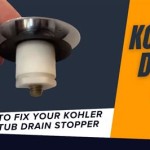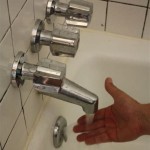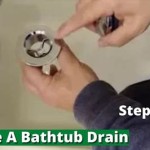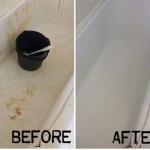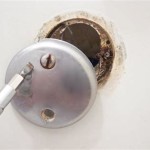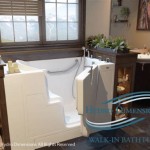How to Fix Standing Water in Bathtub
Standing water in a bathtub is a common plumbing issue that can range from a minor inconvenience to a symptom of a more significant problem. Understanding the potential causes and implementing effective solutions is crucial for maintaining a functional and hygienic bathroom. This article provides a comprehensive guide on identifying the reasons for standing water in a bathtub and offers detailed instructions on how to address them.
Identifying the Cause of Standing Water
Before attempting any repairs, it is essential to accurately diagnose the cause of the standing water. Several factors can contribute to this problem, and a thorough inspection is necessary to determine the most appropriate course of action. Ignoring the underlying issue can lead to recurring problems or even exacerbate existing damage.
One of the most frequent culprits is a clogged drain. Hair, soap scum, and other debris accumulate over time, forming a blockage that restricts water flow. This blockage typically occurs within the drainpipe itself or in the P-trap, the curved section of pipe located under the bathtub. The P-trap is designed to trap debris and prevent sewer gases from entering the bathroom, but it also makes it a prime location for clogs to form.
Another potential cause is a faulty bathtub stopper. The stopper is the mechanism that seals the drain to allow the tub to fill with water. Over time, stoppers can become damaged, misaligned, or corroded, preventing them from forming a tight seal. This can lead to water slowly draining even when the stopper is in the closed position, which may be mistaken for a slow drain caused by a clog.
In some cases, the problem may lie further down the drain line. Buildup within the pipes or even issues with the main sewer line can impede water flow from the bathtub. These situations often require more advanced troubleshooting and may necessitate the assistance of a professional plumber.
Examining the overflow drain is also important. The overflow drain is located near the top of the bathtub and is designed to prevent the tub from overflowing. If the overflow drain is clogged, it can restrict airflow and hinder the drainage process. A clogged overflow drain often manifests as slow drainage even when the main drain is clear.
Finally, consider the potential for pipe corrosion or damage. Older plumbing systems, particularly those made of metal, are susceptible to corrosion over time. Corrosion can narrow the diameter of the pipe, restricting water flow. In severe cases, pipes can even collapse, leading to significant blockages. Similarly, physical damage to the pipes, such as cracks or breaks, can impede drainage and cause water to accumulate in the bathtub.
Clearing a Clogged Drain
Once a clogged drain has been identified as the likely cause of the standing water, several methods can be employed to clear the blockage. These range from simple DIY techniques to more involved procedures that may require specialized tools.
The first and often most effective method is to use a plunger. Ensure there is enough water in the bathtub to cover the cup of the plunger. Create a tight seal around the drain opening with the plunger cup. Vigorously plunge up and down for several minutes, maintaining the seal as much as possible. The pressure created by the plunging action can dislodge the clog and allow the water to drain. Periodically check if the water is draining by lifting the plunger. Repeat the process if necessary.
If plunging does not resolve the issue, a drain snake, also known as a plumbing snake or auger, can be used. These tools are designed to reach further into the drainpipe and break up or retrieve clogs. Insert the drain snake into the drain opening and carefully feed it down the drainpipe. Rotate the snake as you advance it to help it navigate around bends in the pipe. When you encounter resistance, this indicates that you have reached the clog. Continue to rotate the snake to break up the clog or hook onto it. Once you have dislodged the clog, slowly retract the drain snake, removing any debris that is attached to it. Run water down the drain to ensure that the clog has been completely cleared.
Chemical drain cleaners are another option, but their use should be approached with caution. These cleaners contain harsh chemicals that can corrode pipes and pose a risk to human health. If using a chemical drain cleaner, carefully follow the manufacturer's instructions and wear appropriate protective gear, such as gloves and eye protection. Pour the cleaner down the drain and allow it to sit for the recommended amount of time. Flush the drain with plenty of water after the allotted time has passed. It is generally recommended to avoid frequent use of chemical drain cleaners, as they can damage plumbing systems over time. Consider using enzymatic drain cleaners as a safer alternative. Enzymatic cleaners use natural enzymes to break down organic matter and are less likely to damage pipes.
A simple homemade solution can also be effective for clearing minor clogs. Combine one cup of baking soda with one cup of vinegar and pour the mixture down the drain. Allow the mixture to fizz for about 30 minutes, then flush the drain with hot water. The chemical reaction between the baking soda and vinegar can help to dissolve grease and other debris. This method is generally safer for pipes than chemical drain cleaners and can be used as a preventative measure to keep drains clear.
If the clog is suspected to be located in the P-trap, it can be disassembled and cleaned. Place a bucket under the P-trap to catch any water or debris. Use a wrench to loosen the slip nuts that connect the P-trap to the drainpipes. Carefully remove the P-trap and empty its contents into the bucket. Clean the P-trap thoroughly, removing any accumulated debris. Reassemble the P-trap, ensuring that the slip nuts are tightened securely. Run water down the drain to check for leaks.
Addressing Stopper Issues and Other Drainage Problems
If the standing water is not caused by a clogged drain, the problem may lie with the bathtub stopper or other components of the drainage system. Addressing these issues requires a different approach.
Inspect the bathtub stopper for any signs of damage or misalignment. If the stopper is loose or corroded, it may need to be replaced. Bathtub stoppers come in various styles, including lift-and-turn, pop-up, and toe-touch. Choose a replacement stopper that is compatible with your bathtub's drainage system. To replace the stopper, remove the old stopper by unscrewing it or lifting it out of the drain. Install the new stopper according to the manufacturer's instructions. Test the new stopper to ensure that it creates a tight seal and prevents water from leaking out of the bathtub.
For pop-up stoppers, the linkage mechanism that connects the stopper to the lever can become misaligned. Adjusting this linkage can often resolve the problem. Locate the access panel behind the bathtub faucet. Remove the panel to access the linkage mechanism. Loosen the screw that holds the linkage in place and adjust the position of the linkage until the stopper seals properly. Tighten the screw to secure the linkage in its new position. Test the stopper to ensure that it is working correctly.
If the overflow drain is clogged, it can be cleared using a similar technique as clearing the main drain. Use a drain snake to remove any debris that is blocking the overflow drain. Alternatively, you can use a wet/dry vacuum to suck out any debris that is lodged in the overflow drain. Cover the main drain opening with a cloth to prevent any debris from being sucked into the main drain. After clearing the overflow drain, run water down the main drain to ensure that the water drains properly.
For older homes with corroded pipes, replacing the affected sections of pipe may be necessary. This is a more involved repair that typically requires the assistance of a professional plumber. Replacing corroded pipes can significantly improve drainage and prevent future problems. New pipes, made of materials such as PVC or copper, are resistant to corrosion and will provide years of reliable service.
If the standing water is due to a problem with the main sewer line, professional help is essential. Signs of a sewer line issue include multiple drains backing up, foul odors emanating from drains, and gurgling sounds coming from the plumbing system. A plumber can use specialized equipment, such as a sewer camera, to inspect the sewer line and identify the cause of the problem. Sewer line repairs can range from clearing a blockage to replacing damaged sections of pipe.

How To Easily Unclog Bathtub Shower Drain In 5 Minutes Jonny Diy

How To Clear A Clogged Bathtub Drain This Old House

How To Unclog A Bathtub Drain With Standing Water Naturally
How To Unclog My Bathtub Drain With Standing Water In It Quora

How To Unclog A Bathtub Drain 11 Diy Clog Busters

How To Unclog A Shower Drain With Standing Water Best S

How To Unclog A Bathtub Drain 11 Diy Clog Busters

How To Unclog A Bathtub Drain 11 Diy Clog Busters

How To Unclog A Bathtub Drain Without Chemicals

How To Unclog A Bathtub Drain Without Chemicals
Related Posts


